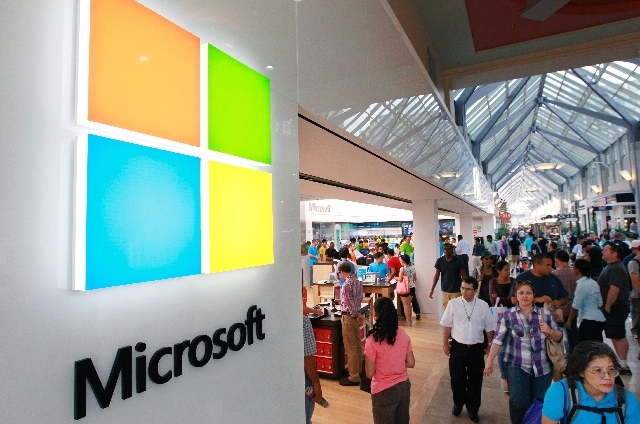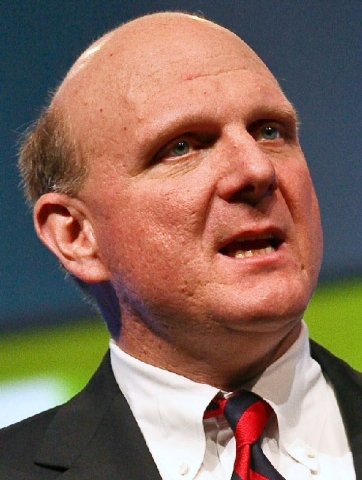Microsoft reboots with sweeping reorganization
SAN FRANCISCO — Microsoft Corp. has decided its entire business needs a new operating system.
CEO Steve Ballmer is restructuring the company to cope with a quickening pace of technological change that has left the world’s largest software maker a step behind its two biggest rivals, Apple and Google.
In an effort to catch up, Microsoft is dismantling an organizational structure that separated the company into sometimes disjointed divisions and hatching a more cohesive product line-up. The new set up revolves around software, devices and services connecting those devices to applications stored in remote data centers — a concept that has become known as “cloud computing.”
The move comes amid a lukewarm response to the latest version of Microsoft’s flagship Windows operating system and a steady decline in demand for personal computers as people increasingly rely on more convenient smartphones and tablets.
If things pan out the way Ballmer envisions, the shake-up announced Thursday will foster more rapid innovation and sharpen the company’s focus on countering the threat posed by mobile devices running on software made by Apple and Google while laptop and desktop computers powered by Windows lose their luster. He is hoping a more closely-knit organization making the software and services that run smartphones, tablets, the Xbox video game console and, yes, PCs will re-establish Microsoft’s reputation as “a company that helps people get stuff done.”
“We are ready to take Microsoft in bold new directions,” Ballmer told analysts and reporters during conference call.
Ballmer, 57, can’t afford to lose his way now. If he does, Microsoft could be even further eclipsed by rivals. That, in turn, could disillusion investors already exasperated with the lackluster performance of Microsoft’s stock since Ballmer succeeded his close friend, company co-founder Bill Gates, as CEO 13 years ago.
During Ballmer’s reign, Microsoft’s stock has slipped by nearly 40 percent even as the company’s annual revenue has roughly quadrupled from $20 billion to nearly $80 billion. The bellwether Standard & Poor’s 500 has climbed by 14 percent during the same time while Apple’s stock price is nearly 17 times higher. By the time Google went public, Ballmer had already been Microsoft’s CEO for four years. Since then, Google’s stock has risen tenfold.
Microsoft’s stock has surged 23 percent in the past three months, partly because the company’s revenue is holding up better than many analysts expected, despite five consecutive quarters of declining PC sales. Some recent buyers of Microsoft’s stock had been betting the company would do something even more dramatic, such as spinning off a division or shedding its unprofitable Internet search engine, Bing, said BGC Financial analyst Colin Gillis. Neither of those appears likely, now that Ballmer has reshuffled the business.
Gillis views the changes as Ballmer’s tacit acknowledgement that Microsoft had become bogged down in bureaucracy and second-guessing —and an admission that there was too much internal strife as various factions formed to protect their turf.
“We have to make the right decisions more quickly,” Ballmer said. The company’s motto now: “One Microsoft all the time.”
Ballmer appears to have the right idea, although it would have looked even smarter had he done it shortly after it became clear that Apple’s 2010 release of the iPad was reshaping the tech market, said Gartner Inc. analyst David Cearley.
“They are really reorganizing for the market reality that has been in place for the last three years,” Cearley said. It would have been nice if it was done earlier, but it’s not too little too late yet. The real key is execution. All these changes make sense and I can see a path forward, but that path forward is a really rocky one.”
Most of Microsoft’s key executives will remain in positions of power at the Redmond, Wash. company although with new roles and more defined responsibilities. The company’s new divisions include engineering, marketing and business development.
Terry Myerson, who had been overseeing Windows Phone, will lead Microsoft’s operating systems and engineering group, namely Windows. Qi Lu, who had been overseeing Bing, will head applications and services.
Microsoft named veteran executive Julie Larson-Green head of its devices and studios engineering group, which will be in charge of hardware development, games, music and entertainment. She had been promoted in November to lead all Windows software and hardware engineering after Steven Sinofsky, the president of its Windows and Windows Live operations, left the company shortly after the launch of Windows 8.
Some of what Microsoft is doing mirrors changes that Apple and Google already have executed.
For instance, Apple put its iOS software for iPhones and iPads along with its operating system for its Mac computer under one executive, Craig Federighi, in a shake-up last year. And Google’s Android software for mobile devices and Chrome software for laptops were aligned under the management of the same executive, Sundar Pichai, for the first time during the spring.
Now, Microsoft hopes to mimic the success of its rivals in a world that increasingly revolves around mobile devices and Internet services. Gartner estimates nearly 867 million devices running on Android software will be shipped worldwide this year, up from 505 million last year. Worldwide shipments of Windows-powered devices are expected to total nearly 340 million this year, down from 346 million last year, Gartner forecasts. But those Windows machines are primarily PCs, not smartphones or tablets. Apple will ship about 296 million iOS and Mac devices this year, up from 213 million last year, Gartner predicted.
Ballmer’s reorganization “should help Microsoft slow its decline, but the question remains whether it will be enough to help it climb into new markets,” Forrester Research analyst Frank Gillett said.
———
Ortutay reported from New York.
























